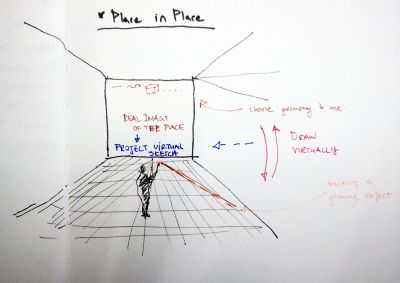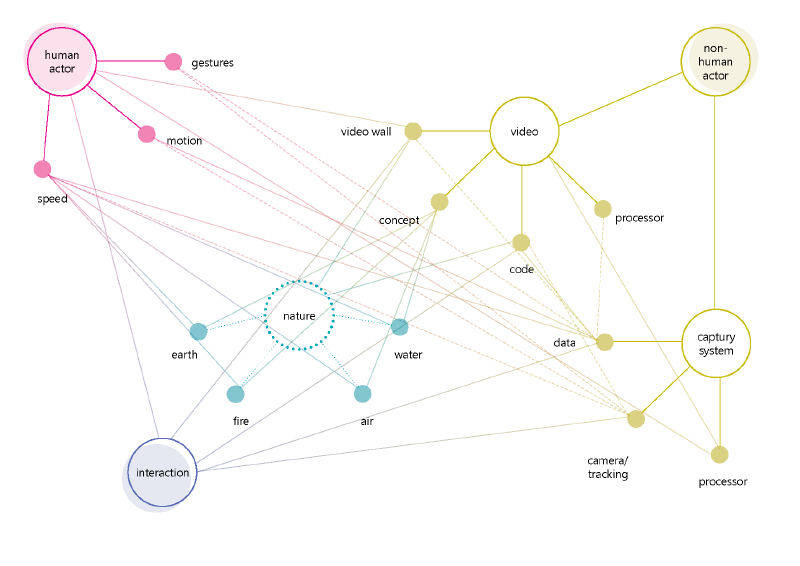Iremnurtokac (talk | contribs) |
Iremnurtokac (talk | contribs) |
||
| Line 19: | Line 19: | ||
Interactivity gets more and more exposed to the field of art, especially as the technology get more affordable and accessible. Aforementioned interaction of the project could also be explained through Actor-Network Theory (ANT). ANT is a sociological theory to explain social networks based on the interactions between human and non-human actors. Even though it is a sociological theory, it applies to the concepts of internet of things, communications in today’s information society. The system, is used in the project, could also be thought as a small network; a network consists of human and non-human actors; captury system (cameras for recording, and a processor where the software runs and all the tracking data is collected), a multi-screen video wall and the video which is projected on the video wall (also generates based on a piece of code and runs on a processor) and a human actor who triggers the interaction among the things in the network. | Interactivity gets more and more exposed to the field of art, especially as the technology get more affordable and accessible. Aforementioned interaction of the project could also be explained through Actor-Network Theory (ANT). ANT is a sociological theory to explain social networks based on the interactions between human and non-human actors. Even though it is a sociological theory, it applies to the concepts of internet of things, communications in today’s information society. The system, is used in the project, could also be thought as a small network; a network consists of human and non-human actors; captury system (cameras for recording, and a processor where the software runs and all the tracking data is collected), a multi-screen video wall and the video which is projected on the video wall (also generates based on a piece of code and runs on a processor) and a human actor who triggers the interaction among the things in the network. | ||
=Some Thoughts For Further Development= | ==Some Thoughts For Further Development== | ||
Revision as of 21:22, 18 September 2017
Place in Place (1st Idea)
- in order to express space we use gestures. these define how we perceive the space.
- How we translate real objects
- could be more people trying to define
- real time video projected on the video wall
Interactive Video || 'Nature Inspired' (Group Project with Esra Demirel)
Ancient Greek philosophers suggested that the nature was formed by four elements, earth, air, fire and water, to degrade the complexity of nature into simple substances. Such approach was also seen among other ancient communities, not only among Greek philosophers. Even though this assumption is not valid today, it is a strong metaphor for conceptualize the nature, especially in art projects. Therefore, this the metaphor of using earth, air, fire and water is adopted to conceptualize the interaction with the nature. In this project, an interactive video installation is to be created where visitors can interact with the video and change the content of the video through their speed.
The motions of the visitors are to be tracked by captury system and relative data is to be send through a communication protocol (in this project, OSC library is used in Processing sketch) to generate the video (Processing sketch). The speed of the motion determines the changes in the sketch representing earth, air, fire and water. Thus, as visitor interacts with the video through mediators. Once the visitor realizes his/her moves changes the video projected, he/she starts to interact more and discover more about the system around him/her. If we think this small art installation, it has its own system which is created on a certain purpose/ foreseen interaction.
Interactivity gets more and more exposed to the field of art, especially as the technology get more affordable and accessible. Aforementioned interaction of the project could also be explained through Actor-Network Theory (ANT). ANT is a sociological theory to explain social networks based on the interactions between human and non-human actors. Even though it is a sociological theory, it applies to the concepts of internet of things, communications in today’s information society. The system, is used in the project, could also be thought as a small network; a network consists of human and non-human actors; captury system (cameras for recording, and a processor where the software runs and all the tracking data is collected), a multi-screen video wall and the video which is projected on the video wall (also generates based on a piece of code and runs on a processor) and a human actor who triggers the interaction among the things in the network.

